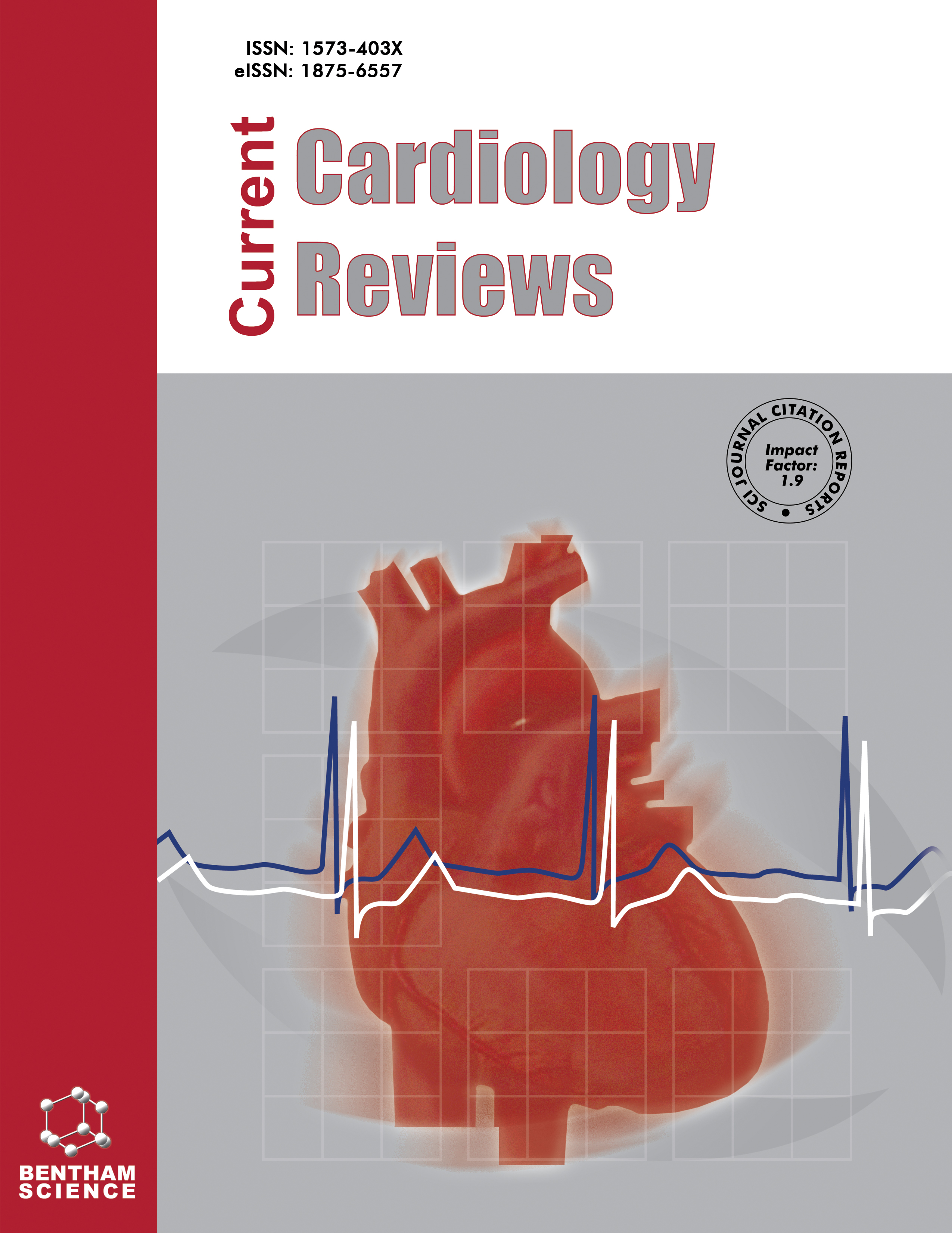- Home
- A-Z Publications
- Current Cardiology Reviews
- Previous Issues
- Volume 20, Issue 6, 2024
Current Cardiology Reviews - Volume 20, Issue 6, 2024
Volume 20, Issue 6, 2024
-
-
CT-derived Fractional Flow Reserve: How, When, and Where to use this Novel Cardiac Imaging Tool
More LessAuthors: Roozbeh Narimani Javid and Seyed Kianoosh HosseiniFractional flow reserve computed tomography (FFRCT) is a novel imaging modality. It utilizes computational fluid dynamics analysis of coronary blood flow obtained from CCTA images to estimate the decrease in pressure across coronary stenosis during the maximum hyperemia. The FFRCT can serve as a valuable tool in the assessment of coronary artery disease (CAD). This non-invasive option can be used as an alternative Read More
-
-
-
Volatilome: A Novel Tool for Risk Scoring in Ischemic Heart Disease
More LessDeveloping a novel risk score for accurate assessment of cardiovascular disease (CVD) morbidity and mortality is an urgent need in terms of early prevention and diagnosis and, thereafter, management, particularly of ischemic heart disease. The currently used scores for the evaluation of cardiovascular disease based on the classical risk factors suffer from severe limitations, including inaccurate predictive values. Therefor Read More
-
-
-
Assessment of Lifetime Risk for Cardiovascular Disease: Time to Move Forward
More LessAuthors: Evangelia G. Sigala and Demosthenes B. PanagiotakosOver the past decades, there has been a notable increase in the risk of Cardiovascular Disease (CVD), even among younger individuals. Policymakers and the health community have revised CVD prevention programs to include younger people in order to take these new circumstances into account. A variety of CVD risk assessment tools have been developed in the past years with the aim of identifying po Read More
-
-
-
A Rare Case of Brucellosis with Multivalvular Endocarditis and Complete Heart Block
More LessBackground Brucellosis is a public health concern that affects multiple organs. However, cardiovascular problems arise infrequently, affecting fewer than 2% of cases, typically presenting as endocarditis. Case Presentation A 50-year male was admitted with low-grade fever, night sweats, weight loss (13 kg), malaise, and generalized weakness for the past 6 months. On clinical examination, he was febrile with 39.0°C, an average h Read More
-
-
-
The Association between Serum Follistatin-like Proteins and Cardiovascular Diseases: A Systematic Review and Meta-analysis
More LessBackground Follistatin-like proteins (FSTLs) are adipomyokines secreted by adipocytes and myocytes. Previous studies have reported an increase in circulating FSTL1 levels in response to cardiovascular injuries. In this study, we conducted a systematic review and meta-analysis to assess the association between circulating FSTLs and Cardiovascular Diseases (CVDs). Methods We performed a comprehensive literature search u Read More
-
-
-
Invasive Treatment of Left Main Coronary Artery Disease: From Anatomical Features to Mechanistic Differences
More LessAuthors: Hristo Kirov, Tulio Caldonazo and Torsten DoenstThere is debate on the best treatment for significant stenoses of the left main (LM) coronary artery. The available evidence is based on four randomized trials, which were either performed specifically to assess patients with LM disease (EXCEL, NOBLE, PRECOMBAT) or had a significant fraction of patients with this disease pattern (SYNTAX). A meta-analysis revealed no difference in periprocedural and 5-year mortality bu Read More
-
-
-
Cardiac Amyloidosis in Venezuela: A Pending Issue
More LessAuthors: Juan Salazar, Mayela Bracho, Carlos Esis and Roberto Añez-RamosCardiac amyloidosis (CA) is an infiltrative disease characterized by the deposition of misfolded proteins in cardiac interstitial tissue. Interest towards studying this pathology has been growing in the last decade, as new epidemiological insights have revealed that it is not as uncommon as previously believed. Likewise, advances in non-invasive diagnostic approaches and the identification of molecules that modify its long-ter Read More
-
-
-
Volatilome is Inflammasome- and Lipidome-dependent in Ischemic Heart Disease
More LessIschemic heart disease (IHD) is a pathology of global interest because it is widespread and has high morbidity and mortality. IHD pathophysiology involves local and systemic changes, including lipidomic, proteomic, and inflammasome changes in serum plasma. The modulation in these metabolites is viable in the pre-IHD, during the IHD period, and after management of IHD in all forms, including lifestyle changes and ph Read More
-
-
-
Heart Disease in Mothers of Children with Duchenne Muscular Dystrophy
More LessFemale carriers of Duchenne Muscular Dystrophy (DMD) carry a heterozygous pathogenic variant in the dystrophin gene and can transmit pathogenic variants to their offspring. DMD is an X-linked recessive disease that affects up to 19.8 in every 100,000 male births. Those carriers with symptoms can be referred to as women with dystrophinopathy. Even among asymptomatic carriers, cardiac involvement can be verifie Read More
-
-
-
A Systematic Review of Economic Evidence of Cardiovascular Interventions in India
More LessAuthors: Saba Abidi, Anandita Nair, Rakhi Ahuja, Shridhar Dwivedi and Sushama TalegaonkarBackground Cardiovascular diseases (CVDs) continue to be the primary cause of mortality globally and invariably in India as well. The rapid upsurge in the prevalence of CVDs in India has created a pressing need to promote contemporary, sustainable, and cost-effective interventions to tackle the CVD burden. This systematic review integrates the research-based evidence of the cost-effectiveness of various interventions that can b Read More
-
Volumes & issues
-
Volume 21 (2025)
-
Volume 20 (2024)
-
Volume 19 (2023)
-
Volume 18 (2022)
-
Volume 17 (2021)
-
Volume 16 (2020)
-
Volume 15 (2019)
-
Volume 14 (2018)
-
Volume 13 (2017)
-
Volume 12 (2016)
-
Volume 11 (2015)
-
Volume 10 (2014)
-
Volume 9 (2013)
-
Volume 8 (2012)
-
Volume 7 (2011)
-
Volume 6 (2010)
-
Volume 5 (2009)
-
Volume 4 (2008)
-
Volume 3 (2007)
-
Volume 2 (2006)
-
Volume 1 (2005)
Most Read This Month
Article
content/journals/ccr
Journal
10
5
false
en


